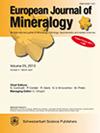超高压榴辉岩中含刚玉和尖晶石复合体在板坯挖掘过程中记录了高温套印和部分熔融
IF 1.7
3区 地球科学
Q2 MINERALOGY
引用次数: 0
摘要
摘要在中国大别地块超高压榴辉岩中发现了白云母之后的含刚玉和尖晶石复合体。根据其矿物组合可识别出三种类型的共生体:(1)刚玉+斜长石+黑云母后白云石(CPB)共生体,(2)尖晶石+斜长石+黑云母后白云石(SPB)共生体,(3)尖晶石+斜长石后paragonite (SP)共生体。复合岩的显微结构和矿物组合,结合局部区域的热力学模拟结果表明,这些复合岩是在榴辉岩麻粒岩相变质叠印(770-850°C)时,在0.8-0.9 GPa的压力下,由辉云母和副云母破碎形成的。白云母在分解过程中发生脱水部分熔融反应,导致沿晶粒(石榴石、金红石、石英)边界形成薄斜类膜(硅酸盐熔体)。质量平衡计算表明,在长云石之后形成CPB和spb共晶石需要引入Al、Ca、Na和Fe,并损失Si、Mg和k。而在长云石之后形成SP共晶石则需要输入Mg、Ca和Fe,去除Si、Al和Na。通过对全球UHP地体中含刚玉和尖晶石共晶体的赋生和生长机理的总结,我们发现这些共晶体的形成既可能是富铝水矿物蓝晶石的亚固相取代,也可能是高温变质过程中富铝水相的脱水熔融作用。研究表明,含白云母榴辉岩在平板发掘过程中,不仅在高压(HP)发掘阶段,而且在低压变质叠印阶段,可能经历了多次局部熔融。蓝晶石是高压部分熔融的反应产物,低压熔融会消耗蓝晶石。我们认为,白云母榴辉岩后出现含刚玉和尖晶石的复体是出土板中LP熔化的潜在矿物学指标。本文章由计算机程序翻译,如有差异,请以英文原文为准。
Corundum-bearing and spinel-bearing symplectites in ultrahigh-pressure eclogites record high-temperature overprint and partial melting during slab exhumation
Abstract. Corundum- and spinel-bearing symplectites after muscovite were found in
ultrahigh-pressure (UHP) eclogites from the Dabie terrane, China. Three
types of symplectites were recognized based on their mineral assemblages:
(1) symplectitic intergrowths of corundum + plagioclase + biotite after
phengite (CPB), (2) symplectitic intergrowths of spinel + plagioclase +
biotite after phengite (SPB), and (3) symplectitic intergrowths of spinel
+ plagioclase after paragonite (SP). The microtextures and mineral
assemblages of the symplectites, in combination with the results of
thermodynamic modeling on local regions, indicate that these symplectites
formed by the breakdown of phengite and paragonite during the granulite-facies metamorphic overprint (770–850 ∘C) of the eclogite at pressures
of 0.8–0.9 GPa. Dehydration partial melting reactions occurred during the
breakdown of muscovite, which leads to the formation of thin plagioclase
films (silicate melts) along grain (garnet, rutile, quartz) boundaries. Mass
balance calculations indicate that the development of CPB and SPB
symplectites after phengite requires the introduction of Al, Ca, Na, and Fe
and loss of Si, Mg, and K. However, the formation of SP symplectites after
paragonite requires the input of Mg, Ca, and Fe and removal of Si, Al, and
Na. By summarizing the occurrence and growth mechanism of
corundum- and spinel-bearing symplectites in global UHP terranes, we find that
such symplectites can form by both the subsolidus replacement of an Al-rich
anhydrous mineral (kyanite) and the dehydration melting of an Al-rich
hydrous phase during high-temperature metamorphism. This study reveals that
muscovite-bearing eclogites may experience multiple episodes of partial
melting during the slab exhumation, not only at the high-pressure (HP)
exhumation stage but also at the lower-pressure metamorphic overprinting stage.
Kyanite is a reaction product during the HP partial melting, whereas the
low-pressure (LP) melting will consume kyanite. We propose that the
occurrence of corundum- and spinel-bearing symplectites after muscovite in
eclogites is a potential mineralogical indicator of LP melting in exhumed
slabs.
求助全文
通过发布文献求助,成功后即可免费获取论文全文。
去求助
来源期刊
CiteScore
2.80
自引率
9.50%
发文量
40
审稿时长
6-12 weeks
期刊介绍:
EJM was founded to reach a large audience on an international scale and also for achieving closer cooperation of European countries in the publication of scientific results. The founding societies have set themselves the task of publishing a journal of the highest standard open to all scientists performing mineralogical research in the widest sense of the term, all over the world. Contributions will therefore be published primarily in English.
EJM publishes original papers, review articles and letters dealing with the mineralogical sciences s.l., primarily mineralogy, petrology, geochemistry, crystallography and ore deposits, but also biomineralogy, environmental, applied and technical mineralogy. Nevertheless, papers in any related field, including cultural heritage, will be considered.

 求助内容:
求助内容: 应助结果提醒方式:
应助结果提醒方式:


